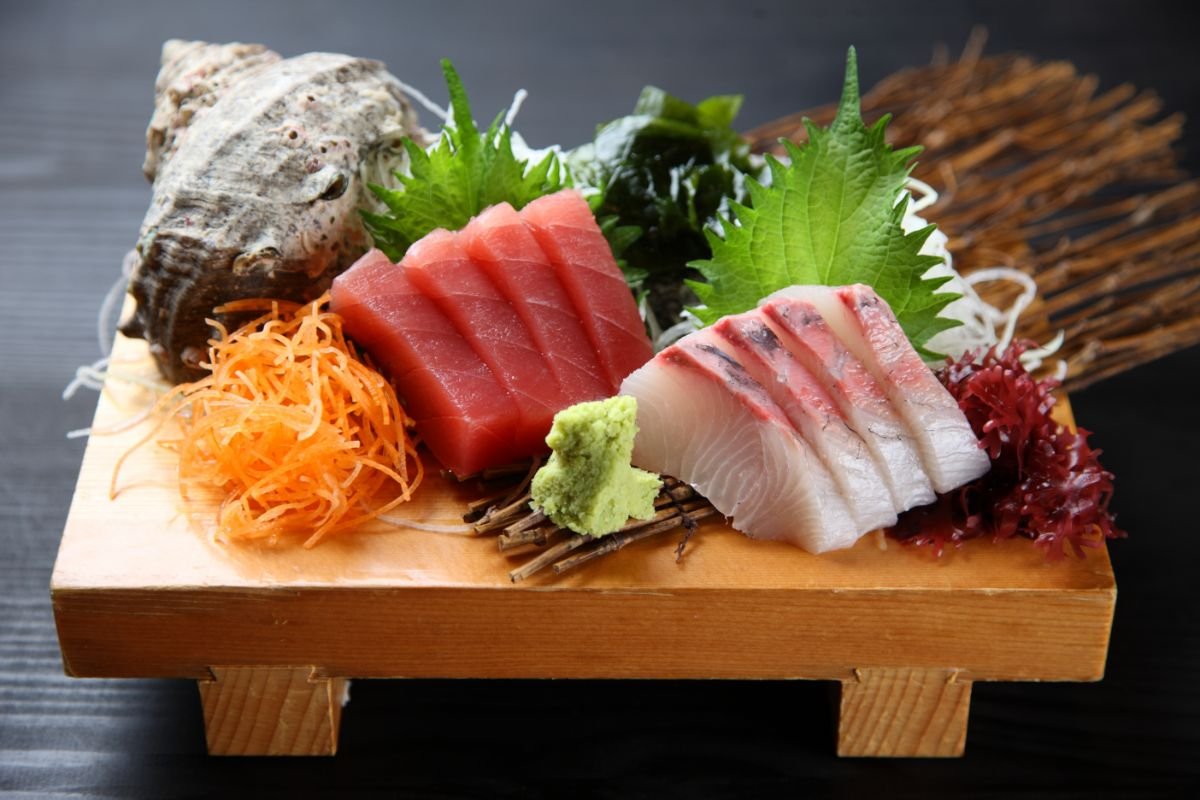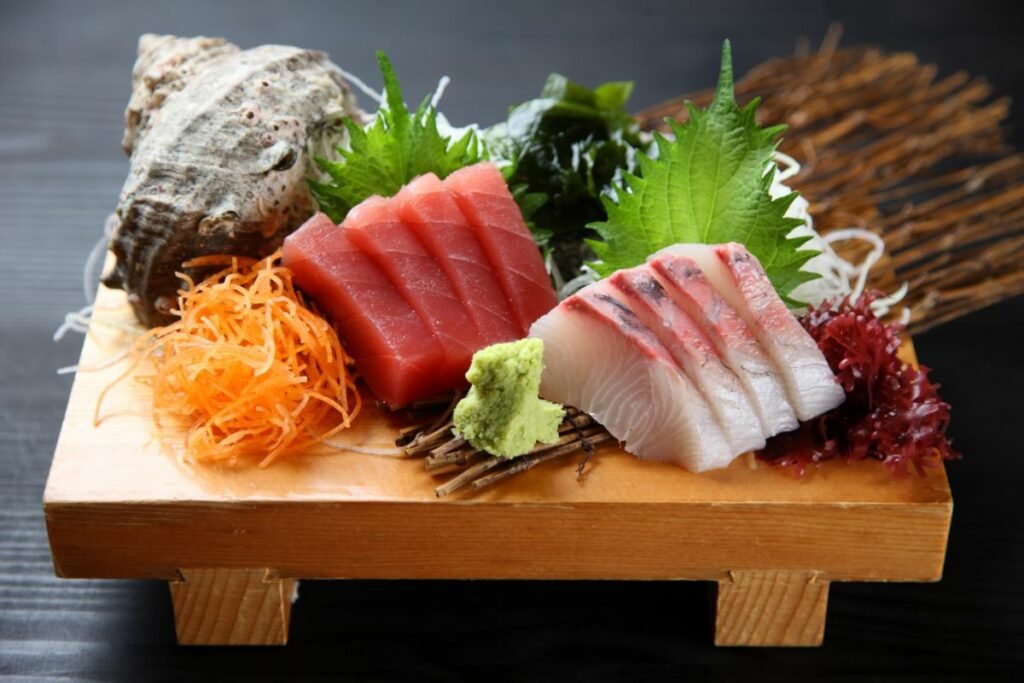Part of the beauty of many Japanese delicacies is that they can be prepared in a plethora of different ways depending on the taste preferences of the person eating them.
Take sushi for example, where you have the option of choosing maki sushi, hako sushi, chirashi sushi, and so many more, giving you an opportunity to experiment and find out what versions of this food you enjoy snacking on the most.

This is also the case with sashimi, a Japanese delicacy that has been enjoyed in the country for several centuries, however, that hasn’t meant that its popularity has slowed down at all, especially because new variations of this seafood dish are being introduced all the time.
If you want to try some sashimi out for yourself, and we definitely recommend that you do, here is everything you need to know about this traditional Japanese cuisine, and the most popular variations of it that many Japanese food lovers argue taste the best.
What Is Sashimi?
Sashimi is a dish that is comprised of pieces of either raw fish or meat that have been thinly sliced and are usually served as a main dish alongside some soy sauce.
Sashimi actually has a very long history within Japan, first being served over 500 years ago during the Muromachi Period.
While the exact origin of the name is not certain, a popular belief is that it originated from the popular method of hunting at that time which was often called “Sashimi-grade fish hunting” where hunters would pierce a fish’s brain with a spike, and because the fish contains lactic acid, this meant that they would not degrade or deteriorate when kept in ice for a few days.
Today, sashimi can be seen being served in many of Japan’s most popular and highest-quality restaurants, with many even considering it to be one of the most premium and finest dishes in the entire country.
The actual meal itself might sound fairly basic, but because of how plain it is on the surface, and how long it has been around, this has given chefs plenty of time to experiment with different flavors and tastes, with there now being many different versions of sashimi all with their own additions and extra ingredients that make them all unique and different from one another.
How To Make Basic Sashimi
Before we start looking at all the different and exciting ways you can try sashimi, it can be worth knowing how to make it at its most basic level so that you know how to whip up this popular dish for yourself, and can even experiment with your own ingredients and garnishes if you feel like you’ve got a good idea in mind.
Here is how to make a basic salmon sashimi dish with soy sauce in just a few minutes:
Ingredients
- 5-6 Oz sushi-grade salmon
- 3 Tbsp of soy sauce
- ¼ Teaspoon of fresh lemon juice
- 5 slices of lemon
- ½ Tbsp of wasabi
Step 1: Slice The Salmon
Start by cutting up the salmon into thin rectangular pieces that are about a quarter of an inch thick.
The key to making the perfect sashimi dish really is making the strips as thin as possible while still giving them just enough chewy texture so that they are still enjoyable to chew down on.
Step 2: Prepare The Soy Sauce
Making the soy sauce is easy, all you need to do is mix it with the wasabi and lemon juice and heat it up over low heat until it starts to boil, and then immediately take it off and allow it to cool so that it won’t overpower the taste of the fish when you come to use it.
Step 3: Add Any Extra Garnishes
If you have any extra wasabi left or any additional seasonings you think would enhance the flavor of the salmon, sprinkle this over the fish and you will have a sashimi dish ready to enjoy, it really is that simple.
Rather than pouring the soy sauce over the salmon, many Japanese chefs will usually keep it in a small pot to act as a dipping sauce instead since the flavor can be very potent, so you don’t want it to overtake the already strong taste of the fish.
Popular Variations Of Sashimi
Now that you know how to make a basic dish of sashimi, it’s time to look at some of the most popular ways Japanese chefs have put their own spin on this Japanese delicacy, and there are many of them.
Bluefin Tuna Sashimi
A sashimi recipe that uses bluefish tuna as the main ingredient is one of the classiest and most premium-styled variants of sashimi you can eat, and this mainly comes from the fish itself which is very highly valued and is the largest tuna fish that can live up to 40 years on average, making them quite the catch for fishermen.
They have the darkest and fattiest flesh of all tuna, giving them a fairly firm texture that is a joy to chew on and tastes a lot more like meat than it does fish.
Another reason it is so highly valued and seen as such a premium dish is because bluefin tuna is extremely nutritious, being a rich source of both vitamin D and vitamin B-12, along with containing Omega-3 fatty acids which help to stabilize blood levels and improve brain function.
While you will sometimes see bluefin tuna sashimi served with a side of soy sauce or a dash of wasabi, a lot of the time it is actually served on its own because of just how much flavor you get from the fish itself, even when the pieces are so thinly cut.
Ika Sashimi
This sashimi recipe uses thinly cut pieces of squid as the core ingredient which have a very bright white appearance and are a lot more rubbery in terms of their texture than most other seafood.
With that being said, squid tends to be quite strong in its flavor, striking a balance between being both sweet and very fishy in taste, so even just a thinly sliced cut of it is enough to light up your tastebuds.
Many Japanese chefs will cut into the tube of the squid since this is the easiest part to make thin strands without having to put too much pressure into the cutting, and they will often make very shallow cuts down the surface until the squid pieces look more like a bowl of noodles than anything.
Ika sashimi is often served on its own with one or two garnishes or even with some lettuce mixed in to even out the sweetness factor.
Sanma Sashimi
Also known in the western world as mackerel pike, the sanma is a redfish that can taste a little bland on the surface, but after adding in some ginger and green onion, the flavor becomes enhanced tremendously, especially because of how fatty it is, making it very juicy once you bite into it.
They are usually caught in Hokkaido, the northern prefecture of Japan, and when used as part of a sashimi recipe, they will almost always be served with extra additions such as hot white rice, soy or kabayaki sauce, and ginger to give the thin cuts enough flavor so that it doesn’t end up tasting too bland or predictable.
Hotate Sashimi
If you’ve never had the pleasure of tasting scallops that have come straight out of their shell, they have an incredibly creamy texture that melts in the mouth with each and every bite, and they taste extremely sweet, making them the perfect ingredient for a sashimi recipe.
While a lot of sashimi fish will often be fairly firm in texture, giving you a good amount to chew down on and enjoy, scallops are quite the opposite and can be eaten and consumed incredibly easily, making them one of the most delicate yet appetizing small dishes you can find in Japan.
When used as part of a sashimi recipe, scallops are usually paired up with lemons or other fresh and light ingredients to make the thin slices taste even more refreshing.
Katsuo Sashimi
Katsuo sashimi is one of the most popular versions of the dish in Japan and is a type of tuna that is cut into knots.
The outer layer of the tuna is sometimes boiled to give it a bit more of a smoky flavor which is also very strong and potent when you come to taste it.
Many people say that it actually tastes very similar to bigeye or yellowfin tuna, but even deeper and with a slightly more rubbery texture that goes down so well when mixed with fresh pieces of fruit and vegetables as part of a light and appetizing sashimi dish.
Katsuo sashimi is usually served with green beans, cucumber, and sometimes tomatoes to help counteract the strength of the tuna so that it can still taste delicious while being a little more manageable to eat.
Ebi Sashimi
Ebi refers to shrimp which is another very popular seafood ingredient that can be found in many restaurants being served as part of a sashimi dish.
Many chefs will skewer and boil the shrimp before then cutting them in half and serving them as sashimi.
With that being said, because shrimps are already so thin, it can be common for chefs to simply use thin shrimps surrounded by extra ingredients and additional garnishes to turn them into a sashimi recipe.
It should be noted that while they can commonly be mistaken for one another, ebi sashimi is not the same as ebi nigiri.
While both do use shrimp as their core ingredient, ebi nigiri also includes sushi rice as part of the dish, while ebi sashimi does not.
Many people will choose to order ebi sashimi over ebi nigiri since sushi rice is full of salt and carbs, so the sashimi variant tends to be much healthier, especially when you mix in some vegetables to give the entire dish a very light and appetizing taste which is perfect to snack on in the warmer months.
Tai Sashimi
You will often find tai sashimi at very high-end 5-star Japanese restaurants, and while it does cost a lot to order, there are also plenty of smaller and more local sushi spots around each city which will serve this delightful sashimi recipe that uses the northern red snapper as its primary ingredient.
Red snapper is known for being very firm in its texture, so even when the chefs break it down into pieces that are less than an inch in thickness, they are still very chewy and bursting with sweet and salty flavors.
It is said by many sashimi enthusiasts that if you are new to sashimi and want a dish that isn’t going to be too strong which could potentially put you off the recipe for good, tai sashimi is one of the best variants to try since it isn’t too heavy in its fishiness, being a lot more mild but still very satisfying to chew on and enjoy.
Tai sashimi is usually served with wasabi to add a slight bit of tanginess to the dish, along with lemons and even honey in some cases to really enhance the natural flavors of the red snapper as much as possible.
Uni Sashimi
Sea urchins have actually been a delicacy in Japan for many years, and many chefs will use them as part of a sashimi recipe because of just how creamy and rich their flavor is, being very similar to oysters in this regard.
Sea urchins are actually known for tasting very salty while still being packed full of sugar and amino acids to give them a very distinct and prominent flavor that explodes once you chew into them, even when it’s just a thin strip used as part of sashimi.
Bonito Sashimi
There aren’t many areas of Japan you can travel to without seeing bonito being served in one way or another, whether it’s grilled up or mixed in with some other fish as part of a delightful sushi recipe, it is one of the most popular fish in Japan due to how frequently it can be caught while fishing, and how it tastes like a combination of both tuna and mackerel.
Because of this, bonito actually has an extremely strong flavor to it which, for some people, can be a little too much when eaten on its own.
Many chefs, when using bonito as part of a sashimi, will therefore garnish it with many different seasonings and use a few added ingredients to help even out the taste enough so that customers can enjoy it.
Many of them will use ginger and grated garlic as a seasoning since these are potent enough to mask the stronger elements of the bonito while still retaining that mackerel-like taste that it is so beloved for.
When served as a sashimi dish, bonito can either still have the skin attached to it in order to give it a little more crunchiness to the texture, or the skin can be completely removed.
Yellowtail Sashimi
Alongside tuna and salmon, yellowtail is another very common type of fish you will find being cut into thin pieces and served as part of a sashimi recipe, and while it does taste a lot like its counterparts, along with also being packed full of minerals and vitamins, many people say that it tastes even fishier and even a little buttery in its texture.
Not only is it extremely healthy and nutritious to eat, but yellowtail is a very cheap fish that can be found in virtually any food store that you walk into in Japan, so it’s also a great fish option to go with if you plan on making a sashimi dish of your own at home.
Tako Sashimi
Octopus is usually incredibly thick and very rubbery when eaten normally in some Japanese meals, so when it comes to using it as part of a sashimi recipe, it’s very important to slice it down to size, otherwise, it can become a little too hard to bite into.
Nonetheless, tako sashimi is still incredibly popular, not only because of the lovely aroma that it gives off after it’s been cut which smells a lot like fried meat, but also because of its deep, rich, and slightly nutty flavor which really is unlike any other seafood out there.
It is also a lot crunchier in its texture than many other types of seafood you will find being used in sashimi.
If you’ve ever eaten lobster, it actually tastes very similar to that, and when octopus is served as tako sashimi, it is often complimented with a dash of wasabi and occasionally kabayaki sauce to add a little more sweetness to the thinly cut slices.
Fugu Sashimi
If you have never tried a blowfish before, you’re missing out on one of the most delicious and savory seafood options out there, with many people saying that it actually tastes a lot more like meat since the fishy flavor is so mild that it’s barely even noticeable.
This is good news for anyone who may not be the biggest seafood lover, but who still wants to try out an authentic sashimi meal for themselves.
Fugu sashimi is only served in a select number of restaurants around Japan because a chef requires a license to be able to prepare food that uses blowfish since some of them require very high amounts of tetrodotoxin which can be deadly if consumed.
With that being said, while it is definitely quite rare, if you do manage to spot it on the menu when you step into a cafe or restaurant, you won’t want to miss the chance to try it for yourself.
How Is Sushi Different From Sashimi
Many people will mistake sushi and sashimi for being the same, and while there are certainly similarities between them such as the fact that they both use sushi-grade fresh fish in their recipes, this is largely where the similarities end.
In a sushi recipe, the fish will either be resting on top of a layer of short-grain rice, or it will be rolled in sushi rice.
This doesn’t always have to be short-grain rice since there are many different variants that will be used depending on the recipe, however, short-grain Japanese rice is most commonly used in the majority of sushi recipes.
In contrast, sashimi uses no rice at all and instead, will use garnishes and extra ingredients to experiment with flavors and enhance the natural taste of the seafood or meat that is at the core of the recipe.
Because of this, sashimi tends to be a lot healthier and more nutritious than sushi since it contains far fewer calories and no carbs due to the rice being removed from the equation.
Sushi on the other hand, while it definitely has a delicious and explosive flavor that is great as the odd snack or as part of an afternoon dinner or evening dessert, can often include ingredients that are very high in fat which will end up adding on far more calories.
Nutritional Benefits Of Sashimi
No matter what variant of sashimi you choose to order from a restaurant or cafe, there are plenty of health benefits that come from doing so that make it a perfect snack to enjoy when you’re trying to watch your calorie intake, or you want something nutritious and refreshing to keep you energized and active for the day ahead.
For one, all sashimi dishes are a fantastic source of lean protein, making it a great post-workout meal that you can cook up in little to no time.
Protein also helps us to feel fuller when compared to other macronutrients, which is a reason why it can be so good for weight loss since while the meal itself is fairly small, it is still enough to help you feel satisfied rather than wanting to snack on something else right after you finish it.
Sashimi meals are also chock-full of Omega-3 fatty acids which have been proven to lower blood pressure, along with promoting brain and heart health.
Many types of fish and other seafood will contain at least a portion of Omega-3 depending on how big they are, meaning any type of sashimi you choose to eat will be extremely beneficial to your health.
Finally, there is the fact that, unlike sushi which can often include so many added ingredients and sauces that it can cause the calorie count to skyrocket, sashimi instead keeps things plain and simple while still being delicious.
The lack of added fatty ingredients and rice means that sashimi always stays low in its overall calorie count, alongside having no carbs at all in most recipes.
Even when it comes to additional sauces such as soy sauce which is very commonly used with sashimi, only a tiny portion is made to compliment the fish, and you won’t find any butter or oil being doused over a plate of sashimi any time you order it.
Summary
Sashimi is an extremely popular Japanese cuisine that has been around for so many years that there have been many twists and variations on the original recipe, giving you plenty of ways to experiment and try this delicious dish for yourself.
Additionally, if you’re currently trying to cut down on your calorie consumption, or you want a small but appetizing meal that is going to give you all the protein you need after a workout, rather than heading straight to the sushi bar, you might want to order a sashimi instead since they are packed full of healthy nutrients and vitamins, or even make one yourself at home.
- What Is a Maiko? - July 13, 2025
- What Does Domo Arigato Mean? - July 12, 2025
- What Does Naruto Mean? - July 12, 2025









